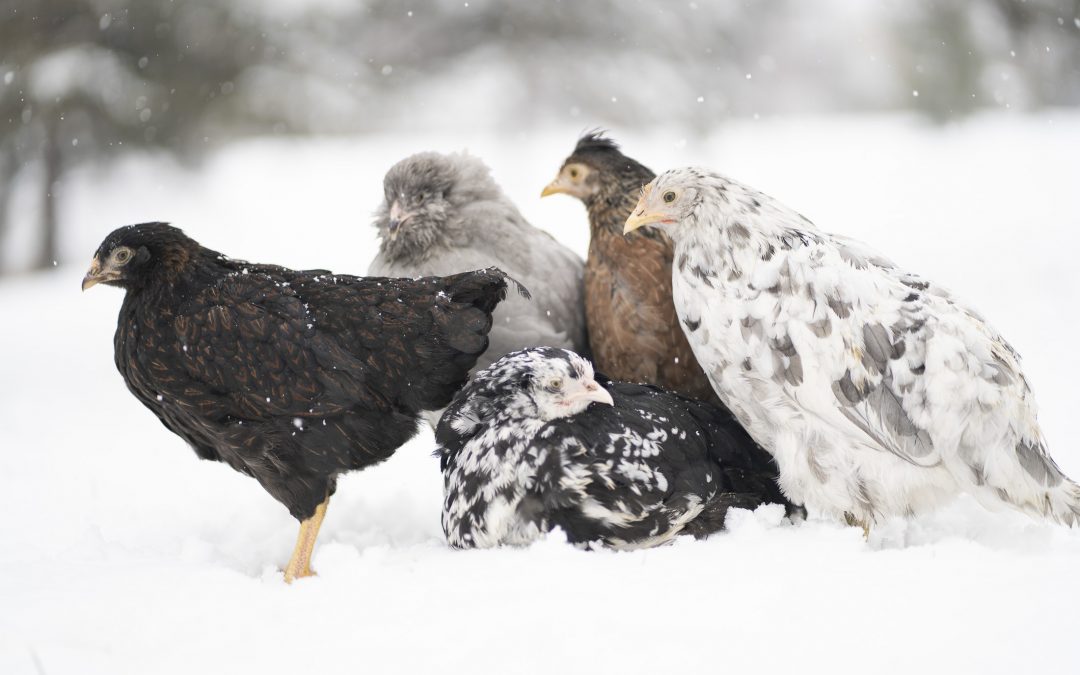One of the questions I get asked most often is, how do I keep chickens warm in winter? I live in Toronto, Canada, where every season brings punishing extreme temperatures, though our winters are pretty mild compared to other Canadian cities.
But we’ll still get the occasional -25 degrees Celsius February evening.
First, let me say that I DO NOT kill my hens. That’s the number one assumption most people make as to what I do with my ladies in the winter.
All my hens live full, happy lives!
So how do my ladies survive long, hard winters? Well, it mostly comes down to their own anatomy.
How Do Chickens Keep Warm in the Winter?
Chickens essentially have on down coats. We have to purchase, over-priced, down-filled parkas to keep warm, but chickens have them built-in.
They’ll also spend a great deal of their time oiling and sealing their feathers by preening daily. This helps to keep moisture out and their body heat trapped in. As long as they keep dry, their feathers keep them warm throughout the lowest of temperatures.
Their legs and feet don’t have feathers, but that’s why I provide a deep layer of hay to protect them from the frozen ground.
The body part at greatest risk to freezing temperatures is their comb. Some chickens have exceptionally large, extravagant combs, while some breeds have little to no combs.
If their coop doesn’t have adequate ventilation and moisture builds up and freezes, their comb will be at risk for frostbite. Even in winter, coop ventilation is critical to your chicken’s comfort and health.
Providing plenty of crushed corn, or other sources of high carbohydrates, in their feed in the fall and throughout winter will help your chickens build up fat stores that act like internal insulation.
Do Chicken Coops Need to Be Insulated?
My answer is both yes and no. I’ll explain.
Insulation stops the loss of heat by using a material on the walls and floors specifically made for that purpose.
Most chicken coops, unless custom built, do not have insulated walls or have anything applied to the walls that will insulate.
Most are made of wood that is insulating even on its own.
In my opinion, and from my experience over 15 winters, coops do not need insulated walls.
But all coops will have a bedding of some sort on the floor. This is where choosing an insulating material for winter is necessary.
Using at least 6 inches or more of hay, or flax hay provides a deep, warm, and insulating bed for the bottom of your coop. Chickens, if especially cold, can make deep nests to sleep in throughout the night.
It will also prevent the punishing radiant cold from coming up from the frozen ground underneath your coop. Remember what I said above about their feet…no feathers means less protection from the cold.
With that much hay at the bottom of your coop, you’ll be able to turn and fluff it up a few times per week to trap the droppings and to bring fresh hay to the top. The deep litter method, and it works beautifully throughout the winter to keep your flock warm and clean.
Chickens Need Protection From Cold Wind Day and Night
Chickens aren’t fans of windy days, no matter what the temperature. But in the winter, a cold wind lifting their feathers and exposing their delicate skin to the freezing temperatures can kill them.
My chicken coop has a covered run enclosed in ¼” hardware mesh. In the winter, I cover all the mesh in thick, construction plastic by stapling it to the frame. With the plastic being transparent, it not only blocks the wind, but it also turns the run into a greenhouse that warms up nicely on sunny days.
I still open the run door and let them out into the courtyard if they’d like, but on unusually cold days, they prefer to stay inside the protected run instead.
I also use flax hay at least 6 inches deep as ground cover in the run to protect their feet from the frozen dirt.
Do Chickens Need Ventilation in the Winter?
The answer to this question is 100% YES. Even in the winter, it’s crucial to have ventilation openings at the very top of the coop.
An airtight coop is not healthy at best, and downright deadly at worst.
Ventilation allows moisture to escape the coop during the night while your flock is sleeping. Moisture comes from not only their respiration but also from their droppings.
If this moisture gets trapped inside the coop, it will land on the chickens (just like a foggy bathroom mirror) and cause frostbite on their combs.
A lack of ventilation in a coop also means that the natural gases created by the droppings won’t be able to escape, and the air within the coop will become toxic.
But don’t confuse ventilation with drafts. A cool draft hitting a chicken all night will kill her no matter what the season.
Drafts are bad for chickens but can be stopped by sealing doors and windows—any location where chickens sleep should be completely free of drafts.
Ventilation at the very top of the coop is not the same as a draft since a vent allows the air to escape, and any air that enters won’t hit the chickens directly as they sleep.
Do Chicken Coops Need To Be Heated?
Whether or not coops need to be heated is a hot topic (pun intended). There’s the group that firmly believes that thick hay bedding, draft-free walls, and high carb foods are all that’s needed to get a flock through winter in Canada.
Then there’s the group, like me, who can’t stand to be warm and cozy in my home while I imagine my ladies are shivering so badly their eggs are coming out pre-scrambled.
Yes, I’m dramatic. My head tells me that I’ve done everything I need to do and that the girls are going to be fine.
My bleeding heart tells me I should do more. So I did.
I purchased two radiant heat panels specifically made for chicken coops. You can view and buy them at the affiliate link below. (I make a small amount of money when you purchase this product through the link below, however I purchased these heaters many years ago…long before this website even existed.)
Mounted on the wall just behind their perches, the ladies are kept toasty by gentle, radiant heat all night long.
This heat panel has a high and low switch…most of the winter, I keep it on high…and I just turn it on when they’re all in the coop for the night. In the morning, I switch it off.
It’s energy-efficient specifically because it emits very low heat. The point of the heater is NOT to heat the air but to provide a warm spot for a chicken to snuggle up to if they’d like.
Heating the air, like with a heat lamp, is dangerous. A heat lamp can quickly turn a coop into a dry sauna, and heat will kill a chicken much faster than cold ever could. Never mind that all that dry hay is just asking to catch fire.
For peace of mind and safety of my hens, I prefer the radiant heating panels in my coop.


